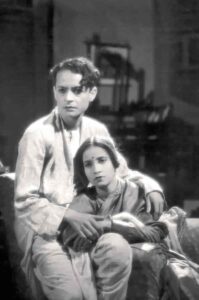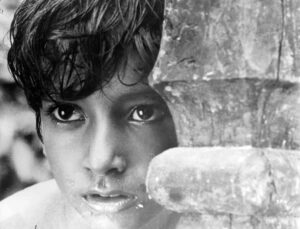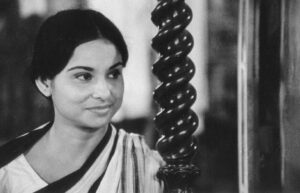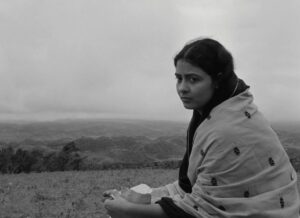by Anushree Ghosh
Cinema evolved from curiosity— The invention of the bioscope provided the idea of moving images –— the different images one after the other felt like a story. This idea was executed when Madan Theatres Limited or Madan Theatres was founded by Jamshedji Framji Madan. Soon, it established itself in showing imported cinema via bioscopes.
Then came the New Theatres, formed by Birendra Nath Sircar in 1930 and it embodied the vision of the Bengali elite. It was positioned to amplify the perception of the cultural superiority of the ‘Bhodroloks’ who were intolerant to the ‘tamasha’ that was being produced in Bombay. The studio created personalities like K.L. Saigal, Kanan Devi, and Bimal Roy, and impacted the whole of India with its quality. It was the time when Bengal was losing its grip and presence in the nation’s politics.

The New Theatre Poster
In Mary-Loise Pratt’s words,
“It was a place where Bengali and English culture met clashed and grappled.”
The moral universe of the “Bhodrolok Culture” consisted of intellectual discussions, staying away from violence, nudity, and portrayal of the indigenous art and culture on celluloid. The sanctity of the artists was to be protected at any cost – which would mean not stepping into the domains of loud theatrical techniques and crossing the threshold of realism. Well, it was difficult to survive with such moral ground rules, however, the Bengali cinema thrived and produced some excellent films, despite having to deal with a lack of equipment and other resources.
Bengali cinema in the Mid-30s
Devadas: The most iconic character in the history of Indian cinema. Made by P.C Barua, it epitomised the angst of Bengal, the economic status of the state, the then-existing communal tension, and the angst of the artist. The protagonist is a self-indulgent romantic who finds solace in drinking alcohol. One can draw parallels with the widespread unemployment and anger that was prevalent amongst the youth. The audience is given a chance to feel empathetic to the person and not look up to the person for his heroic characteristics.

PC Barua and Jamuna in the film “Devdas” (1935)
Bengali Cinema Post 1947
Post 1947, Bengali cinema carried the essence of the Bengal Renaissance, with the cinemas of Satyajit Ray, Ritwik Ghatak, and Mrinal Sen.
Satyajit Ray
The art cinema movement was set in motion with Ray’s Pather Panchali (1955). It was based on the story written by the Bengali author Bibhutibhushan Bandyopadhyay and was a testament to his deep engagement in Bengali literature which was inspired by Bengal’s deep-rooted reality. Ray’s international recognition, first at Cannes in 1956, and his presence on the international film scene worked to embed among common Bengalis the fascination for Bengali cinema.

Subir Banerjee in Pather Panchali
Mrinal Sen
The Bengal famine and refugee crisis have made matters worse for the province. People from rural areas began to move towards Calcutta, which was perceived as the center for opportunities at that time. The radical youth politics – the causes and consequences were explicitly portrayed in Calcutta 71, where Sen took the liberty to show the ruthless chaos that was spreading like wildfire. Sen made a bold political statement through his 5 parts narration.

A still from Calcutta 71
Ritwik Ghatak
Ghatak showed the plight of people affected by partitions through several of his works. Unlike his contemporaries, he used metaphors to convey a larger story by sequencing a story within the characters on screen. His critically acclaimed work “Meghe Dhaka Tara’ is one such example where he tried to render the motherland’s pain on being divided for human benefit.

Meghe Dhaka Tara
In the 1960s, 70…90s, and now in 2023 – many things have changed and there has been a lot that happened, to be followed in Part 2.
Till then, can we mull over the fact that – the passing away of Satyajit Ray, Soumitra Chatterjee and other such people who sowed the seeds of value in Bengali cinema, can be termed as “Losing the Last of the Lot who kept the essence of Bengali cinema alive”

